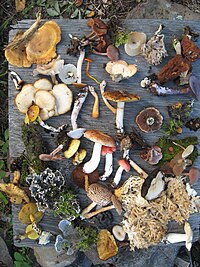
Photo from wikipedia
A bioblitz inexpensively and quickly generates biodiversity data, but bioblitzes are often conducted with haphazard, unreplicated sampling. Results tend to be taxonomically, geographically, or temporally biased, lack metadata, and consist… Click to show full abstract
A bioblitz inexpensively and quickly generates biodiversity data, but bioblitzes are often conducted with haphazard, unreplicated sampling. Results tend to be taxonomically, geographically, or temporally biased, lack metadata, and consist of lists of observed taxa that do not enable further analyses or correction for imperfect detection. A rapid, recurring, structured survey (RRSS) uses a structured sampling design and temporal and spatial replication to survey randomly selected sites on a conservation property. We participated in a loosely structured bioblitz and a subsequent RRSS at Big Canoe Creek Nature Preserve in Springville (St. Clair County), Alabama (USA) to compare observed richness derived from the 2 survey approaches. The RRSS data structure enabled us to fit models that accounted for imperfect detection to estimate abundances, occupancy probabilities, and habitat associations. The loosely structured bioblitz data could not be used in such models. We present a new integrated multispecies abundance model that we applied to avian RRSS data. Our model extension enables estimation for the community, employs data augmentation to estimate the number of undetected species, and incorporates covariates. The RRSS generated a more comprehensive and less biased list of observed taxonomic richness than the loosely structured bioblitz (e.g., 73 vs. 45 bird species and 104 vs. 63 insect families from the RRSS vs. loosely structured bioblitz, respectively). Models fit to the RRSS data identified seasonal patterns in avian community composition and allowed for estimation of habitat–occupancy relationships for insect taxa. The RRSS protocol has potential for broad transferability as a standardized, quick, and inexpensive way to inventory biodiversity and estimate ecological parameters while providing an outreach opportunity.
Journal Title: Conservation Biology
Year Published: 2022
Link to full text (if available)
Share on Social Media: Sign Up to like & get
recommendations!